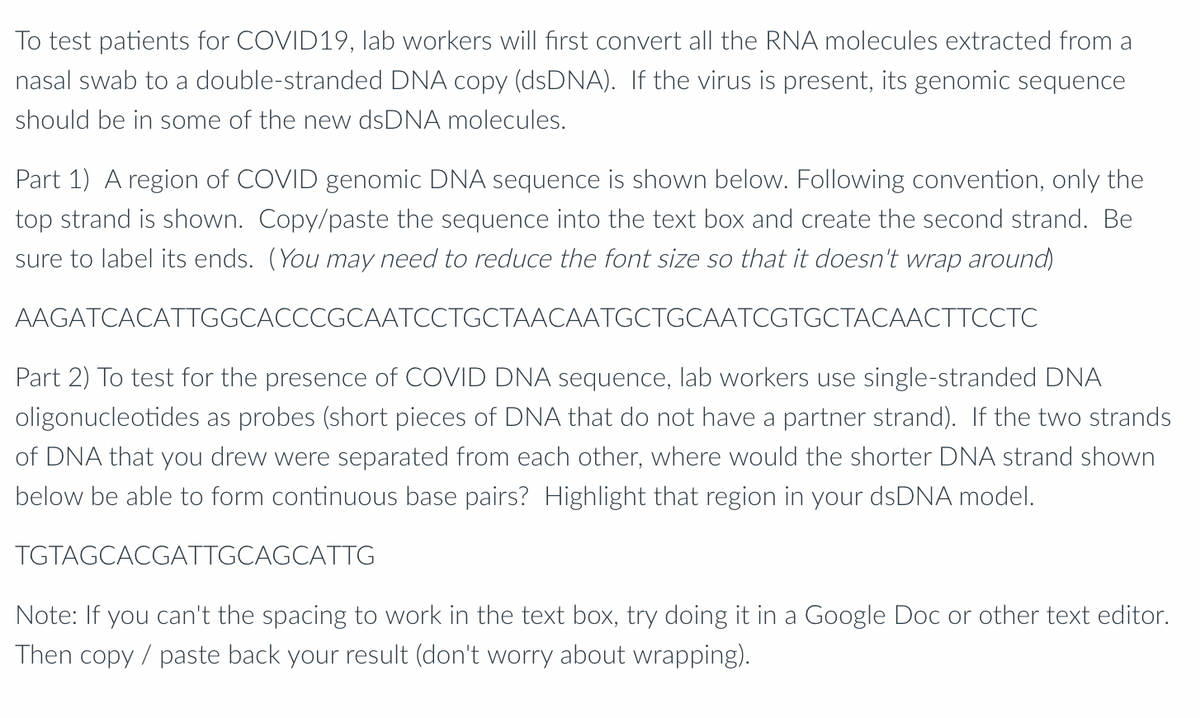To test patients for COVID19, lab workers will first convert all the RNA molecules extracted from a nasal swab to a double-stranded DNA copy (dsDNA). If the virus is present, its genomic sequence should be in some of the new dsDNA molecules. Part 1) A region of COVID genomic DNA sequence is shown below. Following convention, only the top strand is shown. Copy/paste the sequence into the text box and create the second strand. Be sure to label its ends. (You may need to reduce the font size so that it doesn't wrap around) AAGATCACATTGGCACCCGCAATCCTGCTAACAATGCTGCAATCGTGCTACAACTTCCTC Part 2) To test for the presence of COVID DNA sequence, lab workers use single-stranded DNA oligonucleotides as probes (short pieces of DNA that do not have a partner strand). If the two strands of DNA that you drew were separated from each other, where would the shorter DNA strand shown below be able to form continuous base pairs? Highlight that region in your dsDNA model. TGTAGCACGATTGCAGCATTG Note: If you can't the spacing to work in the text box, try doing it in a Google Doc or other text editor. Then copy / paste back your result (don't worry about wrapping).
Gene Interactions
When the expression of a single trait is influenced by two or more different non-allelic genes, it is termed as genetic interaction. According to Mendel's law of inheritance, each gene functions in its own way and does not depend on the function of another gene, i.e., a single gene controls each of seven characteristics considered, but the complex contribution of many different genes determine many traits of an organism.
Gene Expression
Gene expression is a process by which the instructions present in deoxyribonucleic acid (DNA) are converted into useful molecules such as proteins, and functional messenger ribonucleic (mRNA) molecules in the case of non-protein-coding genes.

Replication:
DNA replication is the biological process of making two identical replicas of DNA from a single original DNA molecule in molecular biology. All living organisms have DNA replication, which is the most important aspect of biological heredity. This is required for cell division during tissue growth and repair, as well as ensuring that each new cell receives its own copy of the DNA. The cell has the unique ability to divide, which necessitates the replication of DNA.
DNA is made up of two complementary strands that form a double helix. The double helix is the shape of a double-stranded DNA molecule, which is made up of two linear strands that run in opposite directions and twist together to form a molecule. These strands are split during replication. Semiconservative replication is the process of using each strand of the original DNA molecule as a template for the creation of its counterpart. The new helix will be made up of an original DNA strand as well as a newly synthesised strand as a result of semi-conservative replication. Cellular error-checking and proofreading systems ensure near-perfect DNA replication fidelity.
Trending now
This is a popular solution!
Step by step
Solved in 3 steps


